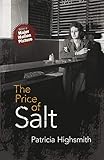
1. “Oh god, how this story emerges from my bones!”
After her debut novel, Strangers on a Train, was made into a hit movie by Alfred Hitchcock in 1951, Patricia Highsmith was under pressure from her publisher and agent to go back to the well and write another “novel of suspense.” But Highsmith, who could be mulish, had different ideas. She had taken a job as a sales clerk in the toy department at Bloomingdale’s during the Christmas rush in 1948 — publication of Strangers was still months away and she was strapped for cash — and in that unlikely setting she received the spark for a new novel. As she would recall 40 years later:
One morning, into this chaos of noise and commerce, there walked a blondish woman in a fur coat. She drifted toward the doll counter with a look of uncertainty — should she buy a doll or something else? — and I think she was slapping a pair of gloves absently into one hand. Perhaps I noticed her because she was alone, or because a mink coat was a rarity, and because she was blondish and seemed to give off light…It was a routine transaction, the woman paid and departed. But I felt odd and swimmy in the head, near to fainting, yet at the same time uplifted, as if I had seen a vision.
 The plain clerk had fallen in love with the radiant woman in the fur coat. Highsmith went home that night and, head still swimming, dashed off eight pages of ideas, plot, and story that would become her second novel, The Price of Salt.
The plain clerk had fallen in love with the radiant woman in the fur coat. Highsmith went home that night and, head still swimming, dashed off eight pages of ideas, plot, and story that would become her second novel, The Price of Salt.
The book astonishes on several levels. First, no one gets murdered, a rarity for a Highsmith novel. Second, it tells the story of a wealthy wife and mother named Carol Aird and a much younger clerk named Therese Belivet (pronounced the French way, Terez) who fall in love with each other and embark on a scandalous, sexually charged cross-country road trip that carries strong undertones of mother-daughter incest — in 1952, the year Dwight Eisenhower was elected president, the year the American Psychiatric Association proclaimed homosexuality a “sociopathic personality disturbance,” and three years before Vladimir Nabokov gave us his account of Humbert Humbert cavorting with his beloved nymphet on their own scandalous cross-country road trip. Third, Carol and Therese are shadowed by a private detective, who tape-records their pillow talk, damning evidence that causes Carol’s tattered marriage to fall apart and forces her to make a wrenching choice: Will she give up custody of her beloved daughter so she can pursue her taboo love for Therese? The answer is yes, which, in Highsmith Country, qualifies as a “happy” ending. All this, as Highsmith noted, in “the days when gay bars were a dark door somewhere in Manhattan, where people wanting to go to a certain bar got off the subway a station before or after the convenient one, lest they be suspected of being homosexual.”
Finally, and most astonishing of all, when the novel came out in paperback it sold hundreds of thousands of copies and generated an avalanche of letters from grateful readers thanking Highsmith for daring to write a book in which two gay lovers wind up happy. The mass-market paperback carried a sizzling kicker: “The novel of a love society forbids.” As Highsmith noted, “Prior to this book, homosexuals male and female in American novels had had to pay for their deviation by cutting their wrists, drowning themselves in a swimming pool, or by switching to heterosexuality (so it was stated), or by collapsing — alone and miserable and shunned — into a depression equal to hell.”
 This is largely, though not entirely, accurate. In 1948, four years before The Price of Salt appeared, Gore Vidal published The City and the Pillar, a novel the homosexual characters of which also manage to avoid the fires of hell and achieve something like happiness. That quibble aside, there is no doubt that Highsmith, who preferred women as sexual partners, was both leery and proud of her controversial book. Fearing career suicide, she published it under the pseudonym Claire Morgan; and years later, after finally acknowledging authorship, she exulted, “Oh god, how this story emerges from my own bones!”
This is largely, though not entirely, accurate. In 1948, four years before The Price of Salt appeared, Gore Vidal published The City and the Pillar, a novel the homosexual characters of which also manage to avoid the fires of hell and achieve something like happiness. That quibble aside, there is no doubt that Highsmith, who preferred women as sexual partners, was both leery and proud of her controversial book. Fearing career suicide, she published it under the pseudonym Claire Morgan; and years later, after finally acknowledging authorship, she exulted, “Oh god, how this story emerges from my own bones!”
2. Something Appalling Yet Irresistible
Now, more than six decades after it was published, The Price of Salt joins the long list of Patricia Highsmith books to be made into a movie. This latest adaptation has been renamed Carol by its director, Todd Haynes, who tackled similar taboo material in Far From Heaven, his reimagining of Douglas Sirk’s 1955 movie, All That Heaven Allows. This new adaptation features Cate Blanchett in the title role and Rooney Mara as Therese, two inspired casting choices — the blondish woman in a fur coat who gives off light, and the dark plain pretty girl, perfect yin and yang. The screenwriter, Phyllis Nagy, has been faithful to the novel without being slavish (she has changed Therese from an aspiring theatrical set designer to an aspiring photographer, and she has cleverly jumbled the time sequence). Since this is a story of infatuation and fuzzy moral boundaries, the movie has an appropriately gauzy look and feel (shot by Edward Lachman). And the ending is perfect, the lovers’ reunion lifted straight from the novel: “Therese waited. Then as she was about to go to her, Carol saw her, seemed to stare at her incredulously a moment while Therese watched the slow smile growing.” Cate Blanchett’s slow smile gives off light, and it announces that, against all odds, these two women are going to stay together and they are going to be happy.

 With Carol, Todd Haynes joins an illustrious roster of directors who have mined Highsmith’s fiction for source material, including Hitchcock, Wim Wenders, Claude Chabrol, René Clément, Anthony Minghella, and Hossein Amini, among others. I first came to Highsmith’s work through Minghella’s 1999 adaptation of The Talented Mr. Ripley, which I watched again recently and found just as shamelessly seductive as it was 16 years ago — all seaside sunshine and sex, with a relentless undertow of evil. Since talented Tom (played by Matt Damon at his very best) gets away with three murders and doesn’t appear to feel a shred of remorse or guilt, I assumed that the appeal of Patricia Highsmith’s fiction is that it operates in an amoral world, where evil deeds not only go unpunished, but are rewarded with a major lifestyle upgrade. This formula brazenly contravenes the Hollywood commandments that evil must be punished and everything must come up roses. Minghella, like Clément before him, bravely embraced it. But this dark formula, it turns out, is not universal in Highsmith Country.
With Carol, Todd Haynes joins an illustrious roster of directors who have mined Highsmith’s fiction for source material, including Hitchcock, Wim Wenders, Claude Chabrol, René Clément, Anthony Minghella, and Hossein Amini, among others. I first came to Highsmith’s work through Minghella’s 1999 adaptation of The Talented Mr. Ripley, which I watched again recently and found just as shamelessly seductive as it was 16 years ago — all seaside sunshine and sex, with a relentless undertow of evil. Since talented Tom (played by Matt Damon at his very best) gets away with three murders and doesn’t appear to feel a shred of remorse or guilt, I assumed that the appeal of Patricia Highsmith’s fiction is that it operates in an amoral world, where evil deeds not only go unpunished, but are rewarded with a major lifestyle upgrade. This formula brazenly contravenes the Hollywood commandments that evil must be punished and everything must come up roses. Minghella, like Clément before him, bravely embraced it. But this dark formula, it turns out, is not universal in Highsmith Country.

 Consider her 1964 novel The Two Faces of January, which was made into a 2014 movie of the same title. It returns us to similar terrain from the first of the five Ripley novels: Americans with lots of money on the loose in the Mediterranean. An alcoholic American con man named Chester MacFarland (Viggo Mortensen) and his wife Colette (Kirsten Dunst) are touring the Greek ruins when they’re spotted as easy marks by a guide/hustler named Rydel (Oscar Isaac). When Chester kills a detective who has tracked him down, he manages to implicate Rydel as an accessory. Then Chester, in a fever of paranoia and jealousy, goes one better by killing Colette and framing Rydel for her murder. Eventually Chester is chased down and shot by the police, and as he dies he confesses to killing Colette, thus exonerating Rydel. It’s a far more conventional — and tepid — ending than The Talented Mr. Ripley.
Consider her 1964 novel The Two Faces of January, which was made into a 2014 movie of the same title. It returns us to similar terrain from the first of the five Ripley novels: Americans with lots of money on the loose in the Mediterranean. An alcoholic American con man named Chester MacFarland (Viggo Mortensen) and his wife Colette (Kirsten Dunst) are touring the Greek ruins when they’re spotted as easy marks by a guide/hustler named Rydel (Oscar Isaac). When Chester kills a detective who has tracked him down, he manages to implicate Rydel as an accessory. Then Chester, in a fever of paranoia and jealousy, goes one better by killing Colette and framing Rydel for her murder. Eventually Chester is chased down and shot by the police, and as he dies he confesses to killing Colette, thus exonerating Rydel. It’s a far more conventional — and tepid — ending than The Talented Mr. Ripley.
Hossein Amini, the writer and director of The Two Faces of January, has said he was attracted to the jealous alcoholic con man at the center of the story. “What I love about Highsmith,” Amini wrote, “is the way that she puts us in the shoes of traditionally ‘unlikeable’ characters, often criminals, and then makes us not only understand their motivations but recognize something of ourselves in them.”
Highsmith attributed her enduring appeal to filmmakers to her obsession with duality, her tendency to let two mismatched characters have at each other — Guy and Bruno in Strangers on a Train, Tom and Dickie Greenleaf in The Talented Mr. Ripley, Chester and Rydel in The Two Faces of January, and now Carol and Therese in Carol. As Highsmith told The New York Times in 1988, “It’s always interesting…when two people opposite in nature get tangled up. I’ve always done that; it’s like pitting good and evil, putting two strong boxers into the ring.”
What sets Highsmith’s characters apart is not only that they are willing, even eager, to commit transgressive acts, but that they are so adept at covering them up and blithely living a lie, or, better yet, seeing to it that someone else gets the blame. As Amini said, we recognize something of ourselves in such people, and we find them both appalling and irresistible. It’s worth noting that Highsmith’s most indelible character, Tom Ripley, is such a slippery chameleon that he has been played, with varying degrees of success, by some very dissimilar actors, including Damon, John Malkovich, Alain Delon, and Dennis Hopper. There’s something appalling yet irresistible in every one of their interpretations of the talented Mr. Ripley.
3. A Bad Bag of Applesauce
Patricia Highsmith was no one’s idea of a warm and fuzzy human being. She kept pet snails. She was a mean-spirited, alcoholic, racist anti-Semite who freely admitted that her mother drank turpentine when she was pregnant with her, in an attempt to abort the fetus. The editor and writer Otto Penzler is a great fan of Highsmith’s writing while acknowledging that she was “a horrible human being.” She was what Fatty Arbuckle would have called “a bad bag of applesauce.”
For all her documented flaws — there have been two scrupulous biographies — Highsmith was also a fanatical maker of fascinating lists. Here’s a beauty she tossed off on Nov. 16, 1973, while living in the French village of Moncourt:
Little Crimes for Little Tots.
Things around the house — which small children can do, such as:
1.) Tying string across top of stairs so adults will trip.
2.) Replacing roller skate on stairs, once mother has removed it.
3.) Setting careful fires, so that someone else will get the blame, if possible.
4.) Rearranging pills in medicine cabinets; sleeping pills into aspirin bottle. Pink laxative pills into antibiotic bottle which is kept in the fridge.
5.) Rat powder or flea powder into flour jar in kitchen.
6.) Saw through supports of attic trap door, so that anyone walking on closed trap will fall through to stairs.
7.) In summer, fix magnifying glass to focus on dry leaves, or preferably oily rags somewhere. Fire may be attributed to spontaneous combustion.
8.) Investigate anti-mildew products in gardening shed. Colorless poison added to gin bottle.
 This list is at once hilarious and chilling and it contains, in distilled form, all the essential elements of Highsmith’s fiction: it’s highly practical, it’s written in unfussy prose, and in the end it’s all about murder. Item #3 is the most telling on the list, with its admonition to set “careful” fires so that “someone else will get the blame, if possible.” Here is the duplicity that lies at the heart of Highsmith’s enterprise — the urge to do evil and not only get away with it, but make sure that someone else gets the blame. In a Highsmith story, culpability for a single crime frequently passes onto two characters (think of Chester and Rydel). Or the victim becomes the victimizer, as in The Cry of the Owl from 1962, which has been adapted for the screen twice, the story of an “innocent” stalker who winds up getting stalked by his “victim.” Highsmith uses this duplicity to ratchet up her favorite states of mind, including anxiety, jealousy, paranoia, dread, self-delusion, and resentment. Small wonder that Highsmith considered herself a writer of psychological novels, not “novels of suspense,” or that one of her favorite writers was Fyodor Dostoyevsky.
This list is at once hilarious and chilling and it contains, in distilled form, all the essential elements of Highsmith’s fiction: it’s highly practical, it’s written in unfussy prose, and in the end it’s all about murder. Item #3 is the most telling on the list, with its admonition to set “careful” fires so that “someone else will get the blame, if possible.” Here is the duplicity that lies at the heart of Highsmith’s enterprise — the urge to do evil and not only get away with it, but make sure that someone else gets the blame. In a Highsmith story, culpability for a single crime frequently passes onto two characters (think of Chester and Rydel). Or the victim becomes the victimizer, as in The Cry of the Owl from 1962, which has been adapted for the screen twice, the story of an “innocent” stalker who winds up getting stalked by his “victim.” Highsmith uses this duplicity to ratchet up her favorite states of mind, including anxiety, jealousy, paranoia, dread, self-delusion, and resentment. Small wonder that Highsmith considered herself a writer of psychological novels, not “novels of suspense,” or that one of her favorite writers was Fyodor Dostoyevsky.
It isn’t much of a stretch to suggest that inveterate list makers are trying to lasso unruly demons, bring some sort of order to inner chaos. My late father was such a person, and it got to the point where he admitted, only half jokingly, that he had started making lists of his lists. That was when I knew he was in trouble. But Patricia Highsmith put my father in the shade. As her list of “Little Crimes for Little Tots” attests, she wasn’t trying to lasso or tamp down her inner demons; she was nurturing those demons, trying to make them as monstrous as possible. She understood that her demons were the source of her dark genius. They are also what will keep drawing filmmakers to her books for years to come.










